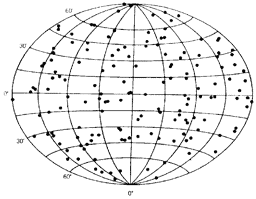 |
Science Frontiers ONLINE No. 83: Sep-Oct 1992 |
|
|
When Isotropy Confounds
 Angular distribution of 153 gamma-ray bursts detected by the GRO satellite in 1991 |
Gamma-ray bursts emanate from highly localized unseen sources. They may last for a few milliseconds or stretch out for several minutes. The energy in the bursts ranges over 26 orders of magnitude. The rise-times of the bursts are so short that the sources can only be a few hundred kilometers across.
Before the accompanying map appeared, most scientists thought that the bursters were nearby, probably in the disk of the galaxy, and were due to asteroids being digested by neutron stars or possibly neutron-star quakes. If such were so, the bursters would be concentrated in the plane of the galaxy (the Milky Way), which clearly they are not. Another theory places the bursters in a distant spherical halo about our galaxy. But, in this case, the bursters would have to be much more energetic than astronomers care to contemplate. In fact, if they exist in a galactic halo, we should also be able to detect the bursters in our neighboring galaxies -- but we do not!
A more exciting suggestion is that gamma-ray bursters are really very close! This would be consistent with the failure to find cosmological redshifts in the burster spectra. Could they be really close, just a few hundred light away? Perhaps arranged in a spherical halo about our solar system in the vicinity of the postulated Oort Cloud of comets? If this were so, they would not have to be nearly as powerful as they would in the neutronstar model. If the gamma-ray bursters really do lurk just at the fringes of the solar system, they must, given their power and small size, be objects completely new to astronomy.
(Schwarzschild; Bertram; "Compton Observatory Data Deepen the Gamma Ray Burster Mystery," Physics Today, 45:21, February 1992.)
Comment. Historically speaking, the gamma-ray bursters were discovered accidentally by satellites launched to detect surreptitious tests of nuclear weapons. Wouldn't it be ironical if our satellites are really monitoring artificial phenomena, generated by battles we can only write science fiction stories about?
Reference. Refer to AOF29 in our Stars, Galaxies, Cosmos for gamma-ray "bursters." Details here.